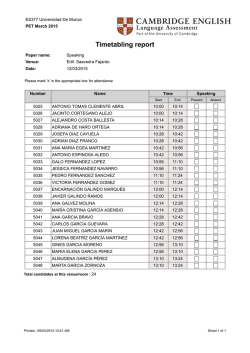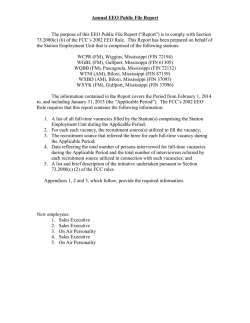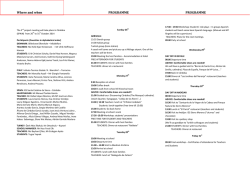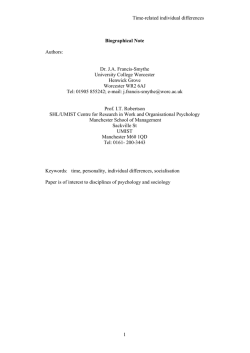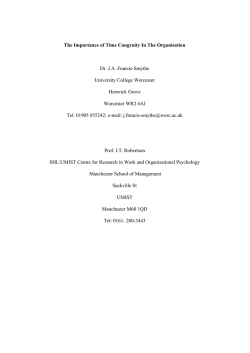
Relaciones entre las Escalas de Personalidad Karolinska y los
Escritos de Psicología, Vol. 8, nº 3, pp. 20-25 Septiembre-Diciembre 2015 Copyright © 2015 Escritos de Psicología ISSN 1989-3809 DOI: 10.5231/psy.writ.2015.2304 Relationships between Karolinska Personality Scales and the new factors and facets of the Zuckerman-Kuhlman-Aluja Personality Questionnaire Relaciones entre las Escalas de Personalidad Karolinska y los nuevos factores y facetas del Cuestionario de Personalidad de ZuckermanKuhlman-Aluja Sergio Escorial 1, Anton Aluja 2,3, Luis. F. García 4,3,5, Óscar García 6 & Angel Blanch 2,3 1 Universidad Complutense de Madrid, España. 2 Universidad de Lleida, España. 3 Institute of Biomedical Research of Lleida, España. 4 Universidad Autónoma de Madrid, España. 5 Instituto de Ciencias Forenses (UAM), España. 6 Universidad Europea de Madrid, España. Available online 31 Diciembre 2015 Psychobiological models of personality are of great use in clinical and research settings given their potential to construct working hypotheses on biological and behavioural correlates, as well as to predict vulnerability to mental disorders. Two personality models are rooted in this psychobiological tradition: Zuckerman`s Alternative Five Factors and the Karolinska Personality Scales (KSP). A new instrument (ZKA-PQ) has been recently developed by Aluja, Kuhlman & Zuckerman (2010) to measure the Alternative Five Factors. The ZKA-PQ incorporates four new facets by each trait. This article analyses areas of overlap and differences between the ZKA-PQ and Karolinska Personality Scales. The total sample comprised 584 subjects (294 men and 290 women). The results suggest that sensation seeking (ZKA-PQ) is mainly associated with monotony avoidance (KSP), neuroticism (ZKA-PQ) with anxiety scales, aggressiveness (ZKAPQ) with every KSP aggression scale, and extroversion (ZKA-PQ) with the detachment scale (KSP). The discussion mainly centres on the information provided by the ZKA-PQ facets beyond basic personality traits, since in certain cases they qualify these general patterns, adding relevant information on the nature of the ZKA-PQ and Karolinska scales. Key Words: ZKA-PQ; Karolinska Personality Scales; Zuckerman’s Psychobiological Personality Model. Los modelos psicobiológicos de personalidad tienen gran mayor utilidad en entornos clínicos y de investigación, dado su mayor potencial para desarrollar hipótesis de trabajo sobre los correlatos biológicos y conductuales, así como para predecir la vulnerabilidad a los trastornos mentales. Dos modelos de personalidad tienen sus raíces en la tradición psicobiológica: El modelo de los cinco factores alternativo de Marvin Zuckerman y el que fundamenta las escalas de personalidad Karolinska (KSP). Un nuevo instrumento (ZKA-PQ) se ha desarrollado recientemente por Aluja, Kuhlman y Zuckerman (2010) para medir los cinco factores alternativos. El ZKA-PQ incorpora cuatro nuevas facetas en cada rasgo. Los solapamientos y las divergencias entre el ZKA-PQ y las escalas Karolinska de Personalidad se analizan en el presente estudio. La muestra total comprende 584 sujetos (294 varones y 290 mujeres). Los resultados sugieren que búsqueda de sensaciones (ZKA-PQ) se relaciona principalmente con la evitación de la monotonía (KSP), el neuroticismo (ZKA-PQ) con las escalas de ansiedad, la agresividad (ZKA-PQ) con las escalas agresión del KSP, y extroversión (ZKA-PQ) con la escala de separación (KSP). La discusión se centra principalmente en la información proporcionada por las facetas ZKA-PQ más allá de los rasgos básicos de la personalidad, ya que estas clarifican en ciertos casos los patrones generales, añadiendo algo de información relevante acerca de la naturaleza del ZKA-PQ y de las escalas Karolinska. Palabras Clave: ZKA-PQ; Escalas Karolinska de Personalidad; Modelo de Personalidad Psicobiológico de Zuckerman. Correspondence concerning this article should be addressed to: Dr. Sergio Escorial Martín. Departamento de Metodología de las Ciencias del Comportamiento. Pabellón II (Despacho 2006-K; buzón 168). Facultad de Psicología. Universidad Complutense de Madrid (Campus de Somosaguas). 28223 Pozuelo de Alarcón. Madrid. e-mail: [email protected]. Co-authors’ e-mails: Anton Aluja: [email protected], Luis F. García: luis. [email protected]; Oscar García: [email protected]; Angel Blach: [email protected]. 20 RELATIONSHIPS BETWEEN KAROLINSKA SCALES AND ZKA-PQ males and 290 women). The average age was 44.50 (SD=18.52). The subjects were recruited among the general population, and were anonymous volunteers. A trained group of students from University of Lleida, and several universities of Madrid collaborated in the data collection. The students had instructions to obtain one man and one woman in each of the following age subgroups: 18-29, 30-39, 40-49, 50-59, and >60. After information about the study was given, students who agreed to participate signed a voluntary consent document. They were informed that results were used for educational and research aims. The study complied with the Code of Ethics of the University of Lleida. The Zuckerman’s personality model has been largely used in applied and basic research within psychobiological (Stelmack, 2004; Zuckerman, 2005) and psychopathological fields (Aluja, Cuevas, García, & García, 2007; Wang, Du, Wang, Livesley, & Jang, 2004; Zuckerman, 1999). On the other hand, Karolinska Scales of Personality (KSP) were built to measure some personality constructs and their underlying biological substrates (Farde, Gustavsson, & Joènsson, 1997; Schalling, 1977; Schalling, Asberg, Edman, & Oreland, 1987). Besides, they have been used on the research about the personality correlates of vulnerability to psychiatric and behavioural disorders (Daderman, 1999; Virkkunen, Kallio, Rawlings, Tokola, Poland, Guidotti, et al., 1994). As far as we know, only two studies have analyzed the relationships between the Zuckerman’s model and the KSP (Zuckerman, Kuhlman, & Camac, 1988; Zuckerman, Kuhlman, Thornquist, & Kiers, 1991). In both articles, Zuckerman’s traits were assessed with the ZKPQ (Zuckerman, Kuhlman, Teta, Joireman, & Kraft, 1993). However, the psychometric assessment of the Zuckerman’s personality model was revised in 2010. Aluja, Kuhlman, and Zuckerman (2010) developed the ZKA-PQ (Zuckerman-Kuhlman-Aluja Personality Questionnaire) that measures the five basic personality factors in a somewhat different way from that used with the ZKPQ. In this instrument, Zuckerman’s basic traits have been renamed as Sensation Seeking, Neuroticism, Aggressiveness, Activity and Extroversion, although its main contribution lies in the inclusion of 4 facets by each personality factor. The selection of facets for broader factors involved content validity that is selection of samples of content that represent the domain of the broader trait. Most facets were selected on the basis of previous work within each of the major trait dimensions in the ZKPQ and other major tests. For instance, facets for the Sensation Seeking trait were based on the theory of sensation seeking and validity studies developed around the construct of a general factor and related subfactors (i.e., facets): Thrill and Adventure Seeking (TAS), Experience Seeking (ES), Disinhibition (Dis), and Boredom Susceptibility (BS) (More details about the rationale of the ZKA-PQ facets for each domain may be found at Aluja et al., 2010). The development of new facets for the Zuckerman’s basic personality traits reinforces the need of this study because it may be helpful to understand the results of biological and psychopathological research conducted with both instruments. Therefore, the aim of the present study is to analyse the convergent and discriminant validity of the new ZKA-PQ in regard to the KSP. It supposes another piece of evidence in the validation process of the ZKA-PQ (e.g., Aluja, Escorial, García, García, Blanch, & Zuckerman, 2013). Measures Zuckerman-Kuhlman-Aluja Personality Questionnaire (ZKA-PQ). The ZKA-PQ (Aluja et al., 2010) measures five personality domains: Sensation Seeking (SS), Neuroticism (NE), Aggressiveness (AG) Activity (AC) and Extraversion (EX). The item response format is a 4-point Likert-type scale from Disagree Strongly, to Agree Strongly. The factor structure is based on the following four facets of 10 items for each trait: Sensation Seeking (SS): SS1 (Thrill and Adventure Seeking), SS2 (Experience Seeking), SS3 (Disinhibition) and SS4 (Boredom Susceptibility/Impulsivity); Neuroticism (NE): NE1 (Anxiety), NE2 (Depression), NE3 (Dependency) and NE4 (Low Self-Esteem); Aggressiveness (AG): AG1 (Physical Aggression), AG2 (Verbal Aggression), AG3 (Anger) and AG4 (Hostility); Extraversion (EX): EX1 (Positive Emotions), EX2 (Social Warmth), EX3 (Exhibitionism) and EX4 (Sociability); and Activity (AC): AC1 (Work Compulsion), AC2 (General Activity), AC3 (Restlessness) and AC4 (Work Energy). In the original validation study, the ZKA-PQ obtained satisfactory alpha reliabilities in American and Spanish samples (Aluja et al., 2010). Karolinska Scales of Personality (KSP).The Spanish version of the Karolinska Scales of Personality (KSP) was administered (Ortet, & Torrubia, 1992). The KSP comprises 135 items (with four-point Likert scale, from 1 “Does not apply at all” to 4 “Applies completely”) grouped into 15 scales: Somatic Anxiety, Monotony Avoidance, Irritability, Muscular Tension, Socialization, Inhibition of aggression, Impulsiveness, Psychic Anxiety, Guilt, Detachment, Psychastenia, Verbal Aggression, Indirect Aggression, Suspicion, Social desirability. Results Table 1 shows the correlations between the facets and domains of the ZKA–PQ and the KSP. Firstly, Aggressiveness facets correlated positively with Irritability (KIR), Verbal aggression (KVA), and Indirect aggression (KINDA), and negatively with Socialization (KSO) and Social desirability (KL). Especially intense is the relationship between Anger (AG3) and Irritability (KIR), and among the facets of Verbal Aggression from both instruments (AG2 and KVA). Second, Neuroticism facets correlated positively with Somatic anxiety Method Participants The total sample was composed by 584 participants (294 21 SERGIO ESCORIAL, ANTON ALUJA, LUIS. F. GARCÍA, ÓSCAR GARCÍA, ANGEL BLANCH Table 1 Pearson correlations between ZKA-PQ and KSP. KSA AG1 KMA KIR .339 .363 .338 .414 KMT KSO KIA KI -.402 -.309 .377 -.326 -.354 .330 KPA KGU KDT KPT .217 KVA KINDA KSU KL .515 .409 .334 -.371 .719 .532 .276 -.366 AG3 .314 .650 .353 -.385 .294 .218 .249 .350 .568 .577 .406 -.477 AG4 .365 .583 .338 -.480 .297 .265 .330 .353 .434 .498 .443 -.537 -.236 -.225 -.450 -.391 -.266 .294 -.214 -.640 -.223 -.324 .335 -.273 -.321 AG2 AC1 AC2 AC3 .300 .278 AC4 -.228 -.234 EX1 -.452 -.349 -.353 .353 EX2 -.276 -.348 -.229 .289 EX3 .390 EX4 .314 .254 .336 -.416 -.285 .283 -.503 -.293 -.213 NE1 .556 .422 .481 -.303 .212 .540 .266 NE2 .622 .366 .521 -.349 .306 .648 .347 .369 .627 .337 -.295 .390 .666 .344 -.242 NE3 .488 .272 .362 NE4 .562 .317 .400 -.291 SS1 .622 -.217 SS2 .673 -.268 SS3 .763 -.356 .490 .253 .225 .333 .611 .281 EX -.327 .250 -.328 -.270 NE .667 .409 .525 SS4 AG .347 .299 .271 -.277 -.233 -.235 .443 .286 .260 -.213 .202 .513 .245 .288 .230 .458 .190 .263 .470 -.213 .205 .266 .326 .228 -.212 .422 .305 .232 .201 -.360 -.260 .481 .223 .218 .212 -.379 -.490 -.281 .407 .694 .619 .447 -.533 -.254 .269 .255 .258 AC SS .787 -.202 -.382 -.114 -.626 -.324 -.333 .401 .747 .390 .160 .564 -.357 -.259 .470 .314 .269 .305 .215 .212 -.203 Note. Correlations > 0.40 are in boldface. Correlations below 0.20 were omitted. ZKA–PQ scales: AG1 = physical aggression; AG2 = verbal aggression; AG3 = anger; AG4 = hostility; AC1 = work compulsion; AC2 = general activity; AC3 = restlessness; AC4 = work energy; EX1 = positive emotions; EX2 = social warmth; EX3 = exhibitionism; EX4 = sociability; NE1 = anxiety; NE2 = depression; NE3 = dependency; NE4 = low self-esteem; SS1 = thrill and adventure seeking; SS2 = experience seeking; SS3 = disinhibition; SS4 = boredom susceptibility/impulsivity); AG: Aggressiveness; AC: Activity; EX: Extraversion; NE: Neuroticism; SS: Sensation Seeking. KPS scales: KSA = somatic anxiety; KMA = monotony avoidance; KIR = irritability; KMT = muscular tension; KSO = socialization; KIA = inhibition of aggression; KI = impulsiveness; KPA = psychic anxiety; KGU = guilt; KDT = detachment; KPT = psychasthenia; KVA = verbal aggression; KINDA = indirect aggression; KSU = suspicion; KL = social desirability. The exploratory factor analyses included was performed following the principal axis extraction and Varimax rotation methods. Following the Zuckerman’s personality model, five factors were requested. The first factor was formed by the four facets of Aggressiveness plus Verbal aggression, Indirect aggression, Irritability and Social desirability scales. The second factor was defined by positive loadings of the facets of Activity only. The third factor was integrated by the Extraversion facets and the Detachment scale. The fourth factor was formed by the facets of Neuroticism together with Psychic anxiety, Somatic anxiety, Muscular tension, Psychasthenia, Inhibition of aggression and Guilt. Finally, the facets of Sensation Seeking defined the fifth factor, plus Monotony avoidance, Impulsiveness and Socialization. (KSA), Muscular tension (KMT), Psychic anxiety (KPA) and Psychasthenia (KPT). Third, the Sensation Seeking facets were positively correlated with Monotony avoidance (KMA) and, to a lesser extent, with Impulsiveness (KI). Fourth, Detachment (KDT) correlated negatively with all Extraversion facets, especially with Social warmth (EX2). Finally, the facets of Activity did not show strong correlations with any of the KSP measures. It deserves to be mentioned that Alpha reliabilities ranged between 0.61 and 0.88 for ZKA-PQ facets, and between 0.88 and 0.92 for ZKA-PQ domains. On the other hand, the reliability coefficients for the Karolinska Scales were within the range 0.22-0.80. These results are consistent with previous studies in Spanish population (e.g. Ortet, Ibañez, Llerena, & Torrubia, 2002), and would indicate poor psychometric properties in several KSP scales (KIR, KIA, KI, KGU, KPT, KINDA, KSU). 22 RELATIONSHIPS BETWEEN KAROLINSKA SCALES AND ZKA-PQ Table 2 Principal axis analysis with Varimax rotation including ZKA-PQ facets and KSP scales. I II III IV .75 -.28 .32 .61 .24 -.34 .52 KSA: Somatic anxiety .60 KMT: Muscular tension .25 KSO: Socialization -.37 KIA: Inhibition of aggression -.37 KI: Impulsiveness .30 .50 .45 KGU: Guilt -.76 KDT: Detachment .26 .73 .59 KVA: Verbal aggression KINDA: Indirect aggression .66 .24 KSU: Suspicion .36 -.57 KL: Social desirability AG1: Physical Aggression .57 AG2: Verbal Aggression .79 AG3: Anger .78 AG4: Hostility .65 .23 -.31 .20 .23 -.23 .35 .24 .27 -.28 .30 .65 AC2: General Activity .25 .52 .66 AC4: Work Energy EX1: Positive Emotions .30 .25 .21 .57 EX2: Social Warmth -.21 .75 EX3: Exhibitionism .24 .43 -.29 -.43 .39 .68 EX4: Sociability NE1: Anxiety .33 .31 .67 AC1: Work Compulsion AC3: Restlessness -.41 .84 KPA: Psychic anxiety KPT: Psychasthenia V .85 KMA: Monotony avoidance KIR: Irritability and Monotony Avoidance, Neuroticism and Anxiety scales, Aggressiveness and Aggression scales, and Extroversion and Detachment. The discriminant validity between both instruments relates mainly with the Activity factor. Focusing on the facets, Monotony Avoidance mainly correlates with Disinhibition. KSP Anxiety scales present the largest correlation with NE2 (Depression). It is also remarkable the high correlations observed between the NE4-Self-Esteem and the KSP Anxiety scales. This pattern of results reinforced the great convergence between Neuroticism/Anxiety and SelfEsteem (Aluja, Rolland, García, & Rossier, 2007; Robins, Tracy, Trzesniewski, Potter, & Gosling, 2001). Indirect Aggression, Suspicion and Social Desirability correlated higher with AG3 and AG4 (Anger and Hostility, respectively) than with AG1 and AG2 (Physical and Verbal aggression, respectively). These outcomes suggest that the main component of aggression assessed by the KSP may be more related with the emotional reactivity component of the situation (i.e. anger). This pattern reinforce the association between Anger and Aggression (Anderson, & Bushman, 2002; del Barrio, Aluja, Spielberger, 2004). The results for the relationship between the Detachment scale and the ZKA-PQ deserves a more in-depth comment. Some divergences have been observed about the location on a factorial space of the Detachment scale (Ortet, et al., 2002). In the previous studies with Zuckerman’s factors, this scale loaded -0.52 (Zuckerman et al., 1988) and -0.63 (Zuckerman, et al., 1991) on the Extroversion-Sociability factors. In the present research, this loading increased to -0.76, suggesting that the relationship with the Detachment scale was closer to the Extroversion factor when the latter incorporates other components beyond Sociability. The fact that the Detachment scale correlates more strongly with the Social Warmth (-0.64) than with the Sociability (-0.50) facet supports this point of view. Therefore, the Detachment scale was linked to both emotional and social distance to others and this duality may help to explain the reasons of the instability of its location on the factorial personality space. Greatly different loadings on the Sensation Seeking factor were reported in the present paper for Monotony Avoidance (0.85) and Impulsiveness (0.50). Besides, the lowest correlation of Monotony Avoidance with the Sensation Seeking facets was observed for SS4 (Boredom Susceptibility/Impulsivity). On the contrary, Impulsiveness presented the largest correlation with SS4. Therefore, these results support the change in content of the ZKA-PQ domains and facets compared with the original ZKPQ. Other KSP scales present a cross-sectional profile considering that they correlated similarly with more than one Zuckerman’s trait. The best example is Socialization. Focusing on correlations, well socialized people are low in Aggressiveness, Sensation Seeking and Neuroticism. The present results show that this pattern is mainly due to low scores in the facets of .33 .67 .24 .78 NE2: Depression .74 NE3: Dependency NE4: Low Self-Esteem -.20 SS1: Thrill/Adventure Seeking .76 -.22 .71 .76 SS2: Experience Seeking .85 SS3: Disinhibition SS4: Boredom /Impulsivity .28 Post rotated % 13.51 .58 5.66 8.34 15.98 11.90 Note. Loadings > 0.40 are in boldface. Loadings below 0.20 were omitted. ZKA–PQ scales: AG1 = physical aggression; AG2 = verbal aggression; AG3 = anger; AG4 = hostility; AC1 = work compulsion; AC2 = general activity; AC3 = restlessness; AC4 = work energy; EX1 = positive emotions; EX2 = social warmth; EX3 = exhibitionism; EX4 = sociability; NE1 = anxiety; NE2 = depression; NE3 = dependency; NE4 = low selfesteem; SS1 = thrill and adventure seeking; SS2 = experience seeking; SS3 = disinhibition; SS4 = boredom susceptibility/impulsivity); AG: Aggressiveness; AC: Activity; EX: Extraversion; NE: Neuroticism; SS: Sensation Seeking. KPS scales: KSA = somatic anxiety; KMA = monotony avoidance; KIR = irritability; KMT = muscular tension; KSO = socialization; KIA = inhibition of aggression; KI = impulsiveness; KPA = psychic anxiety; KGU = guilt; KDT = detachment; KPT = psychasthenia; KVA = verbal aggression; KINDA = indirect aggression; KSU = suspicion; KL = social desirability. Discussion Results suggest that a large amount of common variance (convergent validity) is shared between Sensation Seeking 23 SERGIO ESCORIAL, ANTON ALUJA, LUIS. F. GARCÍA, ÓSCAR GARCÍA, ANGEL BLANCH Physical Aggression and Hostility, Disinhibition and Boredom Susceptibility/Impulsivity, and Depression (Palacios, Sánchez, & Andrade, 2010). The association between Sensation Seeking and socialization is based on the preference for non-legal risky activities, and the constant search for exciting experiences (Zuckerman, 1999). On the other hand, some studies are supportive of the relationship between socialization and Neuroticism (Aluja, & Blanch, 2002; García, Aluja, & del Barrio, 2006; Moreno, Fuhriman, & Selby, 1993). However, the interpretation of this association is less clear. One causal explanation is given by the relationship between Neuroticism and social conditioning raised by the Eysenck’s theory of criminality (Eysenck, & Gudjonsson, 1989). Another interpretation might be based on the tendency of depressive persons to have worse memories (Plomin, McLearn, Pedersen, Nesselroade, & Bergeman, 1988) and lower satisfaction with past and present life circumstances. Note that the present paper reports low reliabilities for some Karolinska scales. In order to improve the psychometric properties of Karolinska Scales of Personality, a new instrument was developed: The Swedish universities Scales of Personality (SSP; Gustavsson, Bergman, Edman, Ekselius, von Knorring, & Linder, 2000). The SSP instrument improved the psychometric properties and retained the validity of the original KPS (Gustavsson et al., 2000). Besides, the SSP seems to present a robust three-factor structure (Aluoja, Voogne, Maron, Gustavsson, Võhma, & Shlik, 2009; Gustavsson et al., 2000). As the SSP represents the evolution of the KSP, a future study should explore the relationships between the ZKA-PQ and the SSP. 5. Aluja, A., Rolland, J.P., García, L.F. & Rossier, J. (2007). Dimensionality of the Rosenberg Self-Esteem Scale and its relationships with the three- and the five-factor personality models. Journal of Personality Assessment, 88, 246-249. http://dx.doi.org/10.1080/00223890701268116 6. Anderson, C. A. y Bushman, B. J. (2002). Human aggression. Annual Review of Psychology, 53, 27-51. http://dx.doi. org/10.1146/annurev.psych.53.100901.135231 7. Aluja, A., Voogne, H., Maron, E., Gustavsson, J.P., Võhma, Ü., & Shlik, J. (2009). Personality traits measured by the Swedish universities scales of personality: factor structure and position within the five-factor model in an Estonian sample. Nordic Journal of Psychiatry, 63, 231 - 236. http:// dx.doi.org/10.1080/08039480802571036 8. Daderman, A.M. (1999). Differences between severely conduct disordered juvenile males and normal juvenile males: The study of personality traits. Personality and Individual Differences, 26, 827–845. http://dx.doi.org/10.1016/ S0191-8869(98)00186-X 9. Barrio del, V., Aluja, A., & Spielberger, C. (2004). Anger assessment with the STAXI-CA: psychometric properties of a new instrument for children and adolescents. Personality and Individual Differences, 37, 227-244. http://dx.doi. org/10.1016/j.paid.2003.08.014 10.Eysenck, H.J., & Gudjonsson, G.H. (1989). The causes and cures of criminality. New York: Plenum. http://dx.doi. org/10.1007/978-1-4757-6726-1 11. Farde, L., Gustavsson, J.P., y Joènsson, E. (1997). D2-dopamine receptor density in brain predicts human personality traits. Nature, 385, 590. http://dx.doi.org/10.1038/385590a0 12.García, L.F., Aluja, A., & Del Barrio, V. (2006). Effects of personality, rearing styles and social values on adolescents’ socialization process. Personality and Individual Differences, 40, 1671-1682. http://dx.doi.org/10.1016/j. paid.2006.01.006 13.Gustavsson, J. P., Bergman, H., Edman, G., Ekselius, L., Von Knorring, L., & Linder, J. (2000). Swedish universities Scales of Personality (SSP): construction, internal consistency and normative. Acta Psychiatrica Scandinavica, 102, 217-225. http://dx.doi.org/10.1034/j.16000447.2000.102003217.x 14.Moreno, J.K., Fuhriman, A., & Selby, M.J. (1993). Measurement of hostility, anger, and depression in depressed and nondepressed subjects. Journal of Personality Assessment, 61, 511–523. http://dx.doi.org/10.1207/ s15327752jpa6103_7 15.Ortet, G., Ibáñez, M.I., Llerena, A., & Torrubia, R. (2002). Underlying traits of the Karolinska Scales of Personality (KSP). European Journal of Psychological Assessment, 18, 139-148. http://dx.doi.org/10.1027//1015-5759.18.2.139 16.Ortet, G., & Torrubia, R. (1992). Spanish language version of the Karolinska Scales of Personality (KSP): First data. VI European Conference on Personality, Groningen. References 1. Aluja, A., & Blanch, A. (2002). The Children Depression Inventory as predictor of social and scholastic competence. European Journal of Psychological Assessment, 18, 259274. http://dx.doi.org/10.1027//1015-5759.18.3.259 2. Aluja, A., Cuevas, L., García, L.F., & García, O. (2007). Zuckerman’s personality model predicts MCMI-III personality disorders. Personality and Individual Differences, 42, 1311-1321. http://dx.doi.org/10.1016/j.paid.2006.10.009 3. Aluja, A., Escorial, S., García, L.F., García, O., Blanch, A., & Zuckerman, M. (2013). Reanalysis of Eysenck’s, Gray’s and Zuckerman’s structural trait models base don a new measure: The Zuckerman-Kuhlman-Aluja Personality Questionnaire (ZKA-PQ). Personality and Individual Differences, 54, 192-196. http://dx.doi.org/10.1016/j. paid.2012.08.030 4. Aluja, A., Kuhlman, M., & Zuckerman., M. (2010). Development of the Zuckerman-Kuhlman-Aluja Personality Questionnaire (ZKA-PQ): A factor/facet version of the Zuckerman-Kuhlman Personality Questionnaire (ZKPQ). Journal of Personality Assessment, 92, 416-431. http:// dx.doi.org/10.1080/00223891.2010.497406 24 RELATIONSHIPS BETWEEN KAROLINSKA SCALES AND ZKA-PQ 17.Palacios, D. J., Sánchez, T. B. y Andrade, P. P. (2010). Intento de suicidio y búsqueda de sensaciones en adolescentes. Revista Intercontinental de Psicología y Educación, 12, 53-75. 18.Plomin, R., McLearn, G.E., Pedersen, N.L., Nesselroade, J.R., & Bergeman, C.S. (1988). Genetic influence on childhood gamily environment perceived retrospectively from the last half of the life span. Developmental Psychology, 24, 738-745. http://dx.doi.org/10.1037/0012-1649.24.5.738 19.Robins, R.W., Tracy, J.L., Trzesniewski, K.H., Potter, J., & Gosling, S.D. (2001). Personality correlates of self-esteem. Journal of Research in Personality, 35, 463-482. http:// dx.doi.org/10.1006/jrpe.2001.2324 20.Schalling, D. (1977). The trait-situation interaction and the physiological correlates of behavior. In Magnusson, N. & Endler, N. (Eds.), Personality at the crossroads; current issues in interactional psychology (p. 129-141). Hillsdale, NJ: Lawrence Erlbaum Associates. 21.Schalling, D., Asberg, M., Edman, G., & Oreland, L. (1987). Markers for vulnerability to Psychopathology: Temperament traits associated with platelet MAO Activity. Acta Psychiatrica Scandinavica, 76, 172-182. http://dx.doi. org/10.1111/j.1600-0447.1987.tb02881.x 22.Stelmack, R. (Ed.) (2004). On the psychobiology of personality. Essays in honor of Marvin Zuckerman. Londres: Pergamon. 23.Virkkunen, M., Kallio, E., Rawlings, R., Tokola, R., Poland, R.E., Guidotti, A., et al. (1994). Personality profiles and state aggressiveness in Finish alcoholic, violent offenders, fire setters, and healthy volunteers. Archives of General Psychiatry, 51, 28-33. http://dx.doi.org/10.1001/ archpsyc.1994.03950010028004 24.Wang, W., Du, W., Wang, Y., Livesley, W. J., & Jang, K. L. (2004). The relationship between the Zuckerman–Kuhlman Personality Questionnaire and traits delineating personality pathology. Personality and Individual Differences, 36, 155– 162. http://dx.doi.org/10.1016/S0191-8869(03)00075-8 25.Zuckerman, M. (1999). Vulnerability to Psychopathology. Washington, DC: American Psychological Association. http://dx.doi.org/10.1037/10316-000 26.Zuckerman, M. (2005). Psychobiology of Personality, 2nd edition, revised and updated. New York: Cambridge University Press. http://dx.doi.org/10.1017/CBO9780511813733 27.Zuckerman, M., Kuhlman, D.M., & Camac, C. (1988). What lies beyond E and N? Factor analyses of scales believed to measure basic dimensions of personality. Journal of Personality and Social Psychology, 54, 96–107. http://dx.doi. org/10.1037/0022-3514.54.1.96 28.Zuckerman, M., Kuhlman, D.M., Teta, P., Joireman, J., & Kraft, M. (1993). A comparison of three structural models of personality: The big three, the big five, and the alternative five. Journal of Personality and Social Psychology, 65, 757-768. http://dx.doi.org/10.1037/0022-3514.65.4.757 29.Zuckerman, M., Kuhlman, D.M., Thornquist, M., & Kiers, H. (1991). Five (or three) robust questionnaire scale factors of personality without culture. Personality and Individual Differences, 12, 929–941. http://dx.doi. org/10.1016/0191-8869(91)90182-B Received 27 January 2015 Received in revised form 22 April 2015 Accepted 23 April 2015 25
© Copyright 2025
